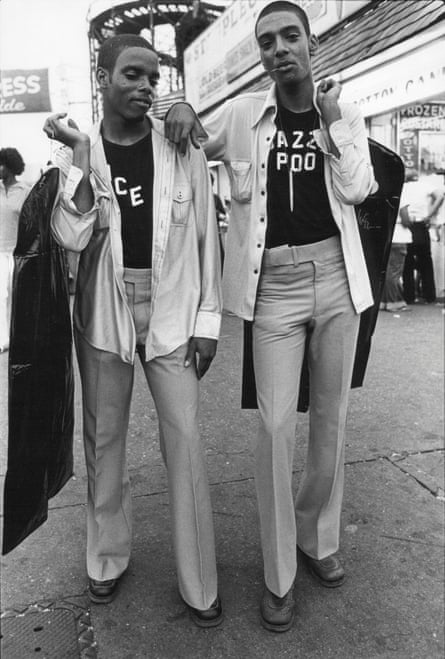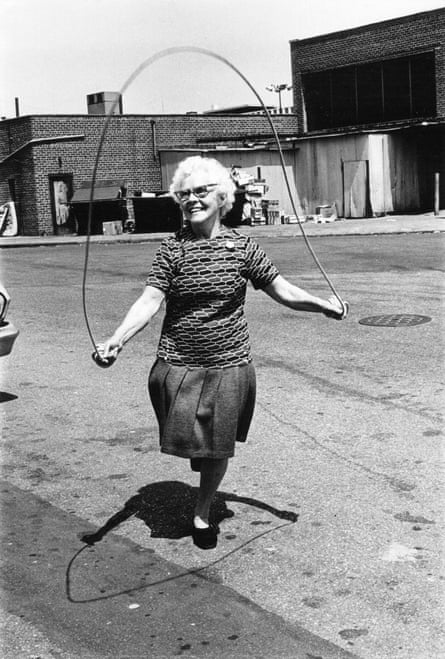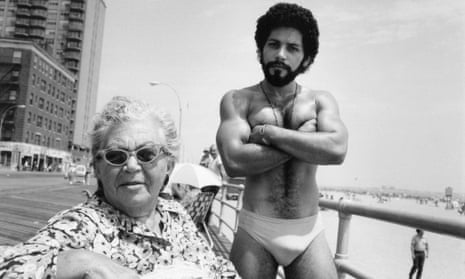It’s the rare New York City photo gallery show that is covered by mainstream American press, television and foreign newspapers, but the reaction to Sometimes Overwhelming is proof that singing photographer Arlene Gottfried, dubbed an “NYC treasure” by Gothamist, is having her moment right now. The show, featuring black and white photography from a pre-gentrified, pre-Instagrammed New York City, includes Brooklynites from long before that borough was a brand and denizens of the city’s parks who have mostly been eradicated.
Her photos capture people with an intimacy and wry humor which hold up in a far more visually saturated world several decades later. Nonetheless, Arlene says “this is the first time I’ve gotten this kind of recognition of my work”, and describes her overall career as “a pain in the neck”. While much respected by photo editors for her eye – and hardcore gospel aficionados for her voice – Arlene has never had the widespread success of her brother Gilbert Gottfried, the standup comic and voice behind Iago the Parrot in Disney’s Aladdin. Indeed, many people who know her sensitive photography, or who hear her sing in church, are shocked when they learn she is the sister of the man behind the crudest version of “the aristocrats” joke.
“How her eye captures people, and how she touches them, that’s hard to explain,”, Gilbert says. “Someone else couldn’t see the funny or odd or touching thing, and capture it. Kind of like how a singer can have a great song, but not know how to sing it. She’s able to do that.”

Arlene, Gilbert and their sister, Karen, grew up in the Coney Island neighborhood of Brooklyn, in a small apartment above the Gottfried Brothers’ hardware store, run by their father and uncle. Karen says some of her siblings’ desire to perform came from their father, Max, who, when the family watched variety shows on a black and white TV, “would get excited when the singers came on, and turn to us and yell: ‘Belt it out!’” Watching variety shows became more mandatory when the family moved to Crown Heights and “lived downstairs from a whole family of dancers who performed on the Ed Sullivan Show”, Karen added.
When Arlene was a teenager, Max gave her an old camera, which she eventually “took to Woodstock, my little 35mm, and I had no clue what I was doing”. She credits her upbringing for her ability to get so intimate with strangers: “We lived in Coney Island, and that was always an exposure to all kinds of people, so I never had trouble walking up to people and asking them to take their picture.”

On capturing the above image – the cover of the book Sometimes Overwhelming – Arlene says: “This was 1980, and we went to the nude beach.” (Her “nude” sounds as “neewwwd” as her “york” sounds like “yaawwwk”.) “In the distance, we see a Hasidic man coming towards the sand, with all his black on, and it was such a hot day. And everyone started looking! And people gathered around him, and this other man, the bodybuilder, walks up, and says, ‘Take a picture of me with him, because I am Jewish, too.’”
Her pictures – whether she asks people to take their portrait or just snaps them (she says she asked a lot more early in her career, not so much now) – get at something incredibly human about them, either from up close or far away.
Gender roles figured prominently in how Arlene got her start. “It was hard to get work as a photo assistant,” she says. “They didn’t think you could carry the equipment.” After finally breaking into work as an assistant at a photo agency, and schlepping her portfolio around town, in the mid-’70s she received her first commission from New York Times magazine. “They had a story about a ‘male secretary’, and in those days that was very peculiar. And they said, ‘Well, she has a bit of peculiarity in her work,’ so that was it.”
Arlene was off, and though there would be a lot of work for the covers of the Times magazine, the Village Voice and Life, “it was always up and down,” says Gilbert. “She’d have exposure, but it would be few and far between.”
While there’s inarguably a great deal of humor in a lot of her sister’s photos, Karen says: “Arlene always respected the people she photographed.” The joke is never condescending. Karen notes that Arlene came around the same time as Annie Leibovitz. “Arlene’s talent was equal, but she didn’t go after the celebrities. She saw greatness in the people walking down the street. That’s why her name is not as known.”
To me, and to most people that know her, Arlene will be as much a singer as she is a photographer. Long before we ever collaborated together in journalism, I met Arlene when we were both singing in the Jerriese Johnson East Village Gospel Choir in the early 2000s. As a soloist, Arlene was no joke: she might be a little white lady, but if you closed your eyes while she sang a somber hymn like God Cares, you would think you were listening to Mahalia Jackson. And if you kept them open during a gospel anthem like Standing in the Need of a Blessing, you could see her filled with the holy ghost.
I asked Gilbert what it was like to see his sister losing her mind for Jesus in a concert at Middle Collegiate Church. Laughing his distinctively explosive Gottfried laugh, he said: “I guess she’s a Jew for Jesus, now. But I don’t think she’ll be trying to convert anybody.” Karen says her son saw his aunt Arlene “literally running up and down the aisle! She ran by us, and my son is young and he looked at her and said: ‘Where are you going?’”
Arlene got into gospel because she is a participant-observer photographer, a kind of anthropologist who is willing to go where the spirit takes her. In 1991, while on assignment, Arlene shot the Eternal Light Community Singers whose leader, Selwyn Rawls, saw something in her and recruited her. She’s been singing ever since.
“That’s how sincere she is,” Karen says of the passion her sister brings to her work. “She got so taken by it, she literally became a part of their choir.”

There isn’t a self-portrait in this show, but if there’s a piece that captures what Arlene’s spirit looks like, I would say it is the one above. Looking around the show last week, Arlene told me that over the years, “it’s hard to sustain yourself when you’re not working” consistently. She thinks the show “looks beautiful, looks complete”, and though she’s still making work, she said this is the satisfaction of an artist seeing her body of work recognized for its simultaneous whimsy and maturity.
- Suddenly Overwhelming is open until 20 December at the Daniel Cooney Gallery in New York. In 2015, Powerhouse books will release Mommie, about Arlene Gottfried’s grandmother, mother and sister.

Comments (…)
Sign in or create your Guardian account to join the discussion